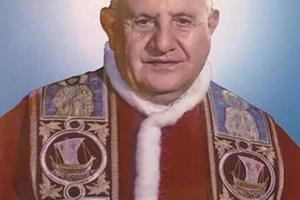Visit John Paul II’s ‘Polish Jerusalem’
Outdoor Shrine Brings Jesus’ Love to Life

Devotion to the passion of Christ was a prominent theme in European Catholic spirituality in the 16th and especially the 17th centuries.
Appealing to pilgrims who otherwise might not have a chance to visit the Holy Land, outdoor Ways of the Cross appeared throughout Europe — including Kalwaria Zebrzydowska, Poland.
Kalwaria Zebrzydowska is a large outdoor pilgrimage shrine, whose beautiful chapels scattered across the grounds are built to the scale of Jerusalem, commemorating the passion and death of Jesus.
Each year, during Holy Week, Christ’s passion is re-enacted among the various chapels. (There is a parallel set of Marian chapels, featuring aspects of the life of the Blessed Virgin. Each year, around Aug. 15, there is an outdoor commemoration of the dormition — "falling asleep" — funeral and assumption of Our Lady.)
The shrine, which dates to 1600, lies about 25 miles south of Kraków. It also lies about 10 miles east of Wadowice. A young boy from that town started visiting Kalwaria, accompanied by his father, in the 1920s.
The boy was Karol Wojtyła, who will be canonized as St. John Paul II on April 27.
The "Polish Jerusalem" was founded by the governor of Kraków, Mikołaj Zebrzydowski. Construction continued under his son, Jan. By 1641, 44 chapels — including six churches — had been built on the grounds.
Mikołaj entrusted Kalwaria to the care of the Bernardine Fathers, a branch of the Franciscan community. Already in 1612, Pope Paul V conceded a plenary indulgence, under the usual conditions, at the hour of death for those who made the Way of the Cross at Kalwaria Zebrzydowska.
Walking the Way of the Cross at Kalwaria, one traces the same distances as Jesus traveled on his way to Calvary.
The 24 chapels recall the traditional Stations of the Cross, plus other events of Jesus’ passion, beginning with the Garden of Gethsemane. (Ten chapels overlap with the "Way of Mary," especially observed at the feast of the Assumption.) Both journeys start at the basilica-church. Pilgrims cross the "Bridge of Angels" to the Mount of Olives, then follow back over the Cedron Bridge and the East Gate to the houses of Annas and Caiaphas, the palace of Herod, the Praetorium of Pilate, and then the chapels of the Way of the Cross, leading to Golgotha and the Church of the Lord’s Grave.
From Palm Sunday through Easter, commemorative events are held daily.
The Polish devotion of "Bitter Lamentations" is also celebrated at Kalwaria, from Palm Sunday through Holy Thursday.
This devotion, which originated in late 17th-century Warsaw, is still celebrated during Lent in churches in Poland, as well as in many Polish-American parishes.
The devotion, which actually is a cycle of three devotions, consists of sung poetic reflections on Christ’s passion. The simple melodies meditate on Christ’s suffering and Mary’s share in it. It is often celebrated before the exposed Blessed Sacrament.
For pilgrims who want to share deeply Christ’s suffering, Kalwaria Zebrzydowska provides a unique experience.
The grounds, reflecting the beauty and quiet of the Polish countryside, facilitate meditation and prayer.
Walking this path — especially remembering that Kalwaria was laid out to bring Jerusalem to those who couldn’t go there — one realizes just what the Passion entailed.
I remember thinking of Christ, virtually at the end of his strength, dragging the wood of the cross, as I climbed the incline that leads to the Chapel of the Third Fall.
But, as John Paul II put it, the Passion led to the Resurrection: "We are the Easter people, and hallelujah is our song!"
This year, pilgrims to Kalwaria Zebrzydowska can combine a visit here with visits to the boyhood home and parish church of Karol Wojtyla in nearby Wadowice, as well as the Shrine of Divine Mercy in Kraków-Łagiewniki, where St. Faustina Kowalska — the "secretary of Divine Mercy" — spent a good part of her religious life and where, as the first saint canonized in the new millennium by John Paul II, lie her remains.
All these holy sites, as well as the holy places in Kraków — of which John Paul II was archbishop for 14 years — are fitting to visit, as they reflect on the saintly life of John Paul II and help us to grow closer to Christ on life’s journey.
As John Paul II reminded us: "In sending us Jesus, the eternal Son made man, God has drawn near to each of us. In Christ, he has become our traveling companion."
John M. Grondelski writes from Shanghai, China.
Planning Your Visit
For those who want to learn more about Kalwaria Zebrzydowska, visit Kalwaria.eu/english.html.
U.S. travelers need to connect via Warsaw, Rome, Frankfurt, Munich or Vienna to Krakow. There are taxis and local buses to Kalwaria, approximately 25 miles from Krakow.
In terms of accommodations, Kalwaria offers a home for pilgrims, from two-bed rooms with bathrooms and larger apartments for bigger groups/families to hostel-like bunk beds. There is both an on-site restaurant and a café, while the little town of Kalwaria Zebrzydowska is within walking distance. The friars are glad to arrange English-speaking guides, with prior notice, to accompany pilgrims and are also available for confessions/spiritual direction. For such contacts and to make housing arrangements, email [email protected].
- Keywords:
- April 20-May 3, 2014

















